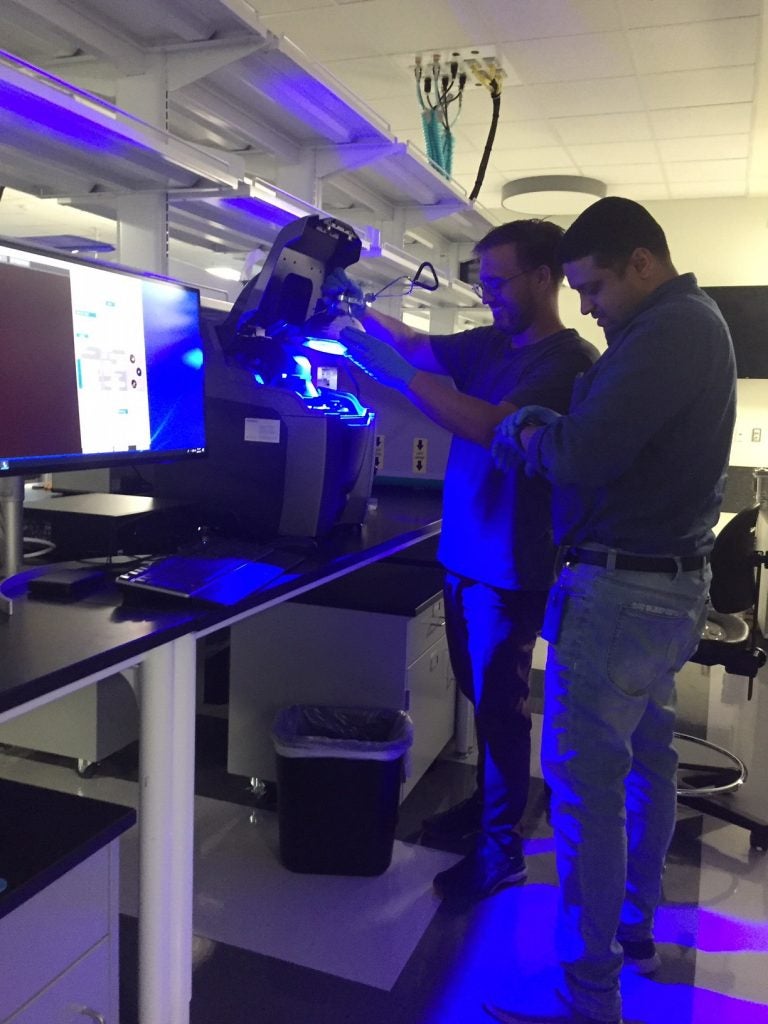ECU students, faculty research proteins that form abnormal clusters during disease, trauma

ECU physical therapy doctoral student Wyatt Bunner and post-doctoral fellow Vishu Prabhu (left to right) work in the lab with the CofActor system. (Contributed photos)
East Carolina University students and faculty in the Thomas Harriot College of Arts and Sciences, College of Allied Health Sciences and Brody School of Medicine are conducting cross-disciplinary collaborative research that may have future therapeutic implications for people affected by Alzheimer’s disease, stroke and heart attacks.
Dr. Robert Hughes, assistant professor of biological chemistry in the Department of Chemistry, and his colleagues Dr. Erzsebet Szatmari, assistant professor in the Department of Physical Therapy, and Dr. Alexander Murashov, associate professor in the Department of Physiology, are examining two sets of proteins within the human body – cofilin (Cof) and actin (Act) – that form unusual clusters during stresses like Alzheimer’s disease and traumatic events that include stroke and heart attacks.
The team, including students from chemistry and physical therapy, has developed a tool called the CofActor system that uses light to trigger the formation of the clusters, allowing them to study what the clusters do once formed.
“From a therapeutic standpoint, we are currently using our system to identify small molecules or peptides that may inhibit cluster formation,” Hughes said.
A portion of the study also seeks to demonstrate which amino acids in cofilin and actin are necessary for the stress response, and the different types and levels of stress needed for the clusters to form.
“We are excited for the possibilities that this tool presents – ranging from fundamental insights into how neurons behave under oxidative stress to the potential for discovering new therapeutic compounds,” Hughes said. “Although still in the early stages of development, this tool has the potential for broad impact in the field of neurodegeneration research.”
Perhaps, in the future, abnormal clusters might be prevented or reversed, limiting the debilitations caused by disease and traumatic events.
Currently, the team’s research is undergoing peer review for publication. They hope to continue working on the project, and next year, they will submit a grant application to the National Institutes of Health for funding of the project.
“Assembling a top-notch interdisciplinary team at ECU has been critical to the success of this project,” said Hughes, who has been working on this research since arriving at ECU in 2016.
Fatema Salem, a doctoral student in chemistry, and chemistry master’s program graduate Abu-Bakarr Kuyateh have been involved with the project for two years. Vishu Prabhu, a post-doctoral fellow in physical therapy, and Wyatt Bunner, a physical therapy doctoral student, have worked on the project for one year. Bunner is incorporating the tool into his doctoral research.
###
ECU News Services
Howard House, 1001 E. Fifth Street
Greenville, NC 27858
ecunews@ecu.edu
Phone: 252-328-6481
news.ecu.edu
Contact: Dr. Robert Hughes, assistant professor of biological chemistry, Department of Chemistry, hughesr16@ecu.edu, 252-328-9730 (office), 919-602-1414 (cell)
